#alvarezsaurid
Explore tagged Tumblr posts
Text

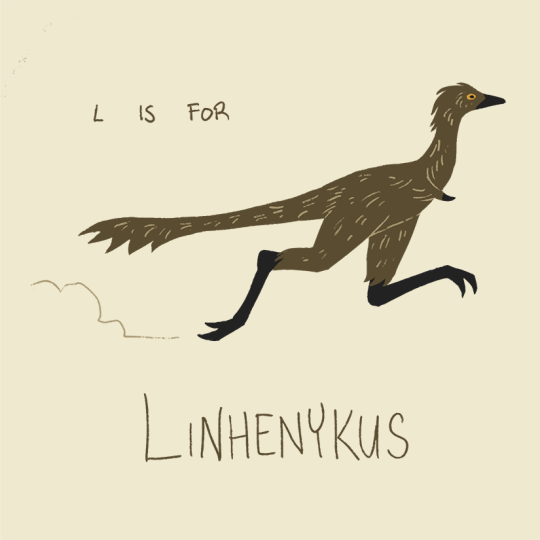
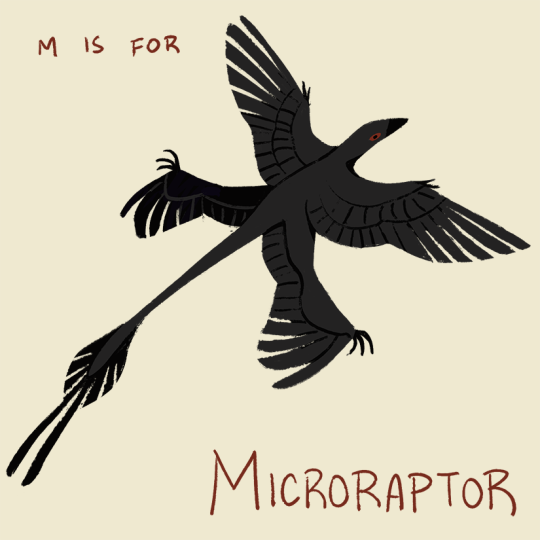
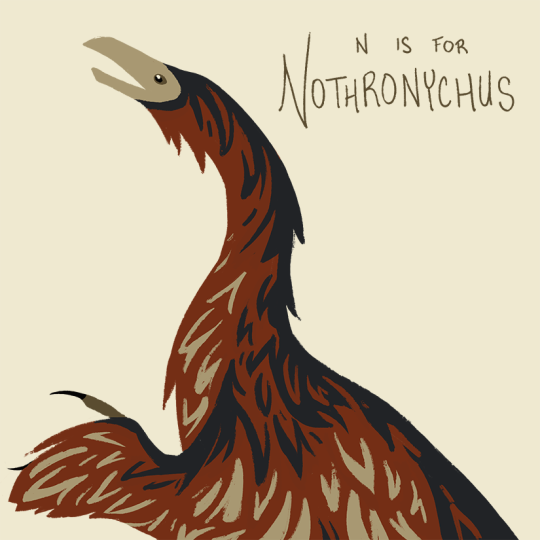

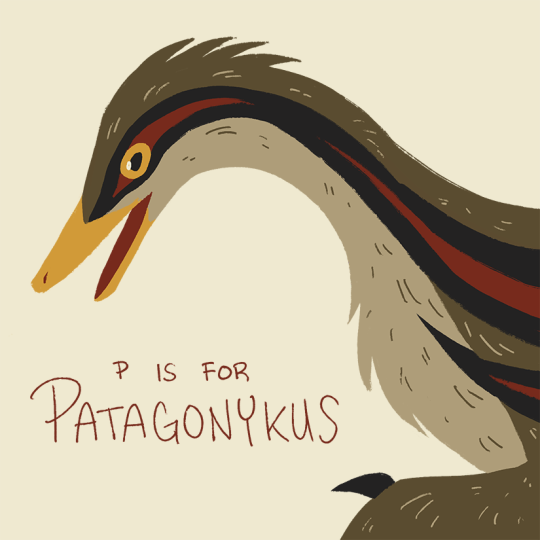
The Maniraptoran Alphabet (Part 3)
Part 3/5 of my dinosaur alphabet! Some of my favorite species in the whole set in this batch, but I'll let you guess which ones those are :)
#dinosaur#alphabet#maniraptoran#oviraptorid#alvarezsaurid#dromaeosaurid#therezinosaurid#khaan#linhenykus#microraptor#nothronychus#oviraptor#patagonykus#paleoart#illustration#artaneae
87 notes
·
View notes
Text
Ok, I finished the dinosaurs.

The large herbivore is called a Savanah Tortan, a large heterodontosaur that evolved from an arboreal ancestor. Meanwhile, the large carnivore is a Savanah Mykin, a large carnivore native to the Korongo islands. This old bull Tortan just had a fight with another younger bull in a battle for mates. Due to his injuries, two mykins, though they could take him.
2 notes
·
View notes
Text

Jaculinykus. The second finger is there, you just have to look closely :3.
#art#my art#digital art#paleoart#paleotology#palaeoblr#archosaurs#dinosaurs#theropods#coelurosaurs#alvarezsaurids#jaculinykus#queue
113 notes
·
View notes
Note
hi! whats a fossil creature youd like to ramble about? i love paleontology and fossils and the history of life and would love to learn more ^w^ hope you have a good day!
you have opened the floodgates.
SO. i shall be talking about alvarezsauroids, a (relatively) newer and highly underrated group of dinosaurs (in my humble opinion). i want you to imagine an ornithomimid, but make it about the size of a turkey, and give it only one big claw on each hand. that's your average alvarezsaur!

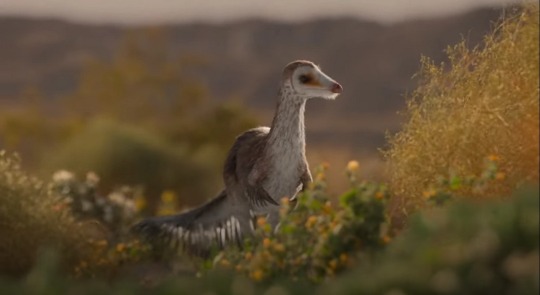
these little guys were basically the anteaters of the mesozoic (though as they were around before any insects started living in colonies, they probably didn't eat just ants). their little arms were quite muscular, and that, combined with their stiffened spine, lever-like arm bones, and big claws meant that they were probably quite good at digging into hard things that bugs like to live in, such as dead wood, or hard dirt.
now, you may be thinking, "but how could they possibly survive off of such little food when there are no eusocial insects?" the answer to that is actually really cool!
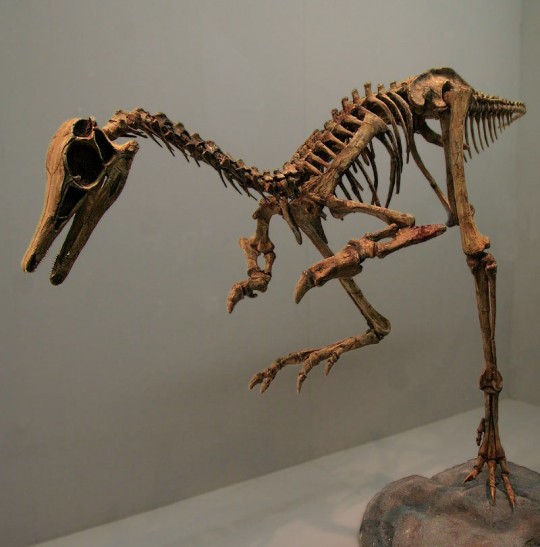
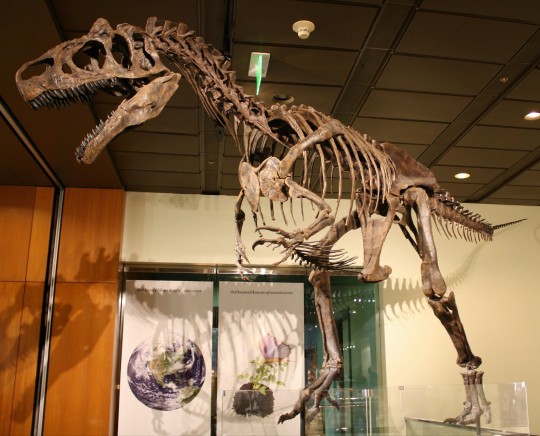
on the left is the skeleton of patagonykus. on the right is the skeleton of allosaurus. take a close look at their feet.


notice how the foot bone (called a metatarsal) in the middle form a triangle in patagonykus? that's because alvarezsauroids are adapted to be very energy efficient for moving over long distances! think of it like a good, laced up running shoe -- you're going to lose less energy through your foot sliding around in your shoe if it's nice and tight, and you'll be able to run for longer without getting tired. the metatarsals have locked together so that alvarezsauroids can travel a long ways without spending as much energy as animals without this adaptation. so they didn't need to eat as much in the first place due to lower energy spend, and they were also able to go a good distance to continue their constant bug buffet.
and now, to conclude, i will show you one of the absolute cutest fossils ever found.

this is a fossil of jaculinykus. while it may just look like a pile of bones, upon closer inspection (and if you know what to look for) you might notice that it looks rather compact, almost like it was curled up.


well, in fact, this lil guy was curled up and cozy. with its lil tail wrapped around it. and it's been sleeping like that for tens of millions of years until we found it and brought it back to life through art. post over i have to go cry about this now
#DISCLAIMER i am not a paleontologist i'm just a guy who really likes paleontology. PLEASE don't be afraid to correct me on anything here#paleoblr#no id#paleontology#cedar speaks#eflatminorseven#asks#alvarezsaurs#alvarezsaurids#alvarezsauroids
42 notes
·
View notes
Text

breme in jail for its crimes (being mean)
based on this
#fossil fighters#fossil fighters breme#everyday vivosaurs au#funfact! if you go on the wiki you can see breme is an alvarezsaurid instead of a dromaeosaurid#so i shifted its design to reflect that#ever since i drew this in january i've been in love with alvarezsaurids#for no particular reason which is funny
21 notes
·
View notes
Text
Archovember 2024 Day 21 - Jakapil kaniukura

Jakapil kaniukura was a basal thyreophoran, the group that led to stegosaurs in the Late Jurassic and ankylosaurs in the Cretaceous. In the Early Jurassic, thyreophorans like Scutellosaurus were small and bipedal, eventually becoming the armoured tanks of later eras.
However, Jakapil lived in the Late Cretaceous of Argentina, at the same time as ankylosaurs on other continents, and its discovery represents a previously unknown lineage of thyreophoran in South America. Though fragmentary, its proportions seem to suggest it was bipedal like the early thyreophorans, and it also had distinct teeth that allowed it to chew, rather than shear leaves. Hopefully we can uncover more information about this strange little armored dinosaur in the future.

Jakapil lived in the Candeleros Formation which, in the Late Cretaceous, was an ancient desert called the Kokorkom Desert. This environment was covered in windblown sand, broken up by oases. Here, the tiny Jakapil would have lived in the shadow of sauropods like Limaysaurus and Rayososaurus, and the giant theropod Giganotosaurus. It would have also lived alongside small theropods like Bicentenaria, Buitreraptor, and the alvarezsaurid Alnashetri, as well as pseudosuchians like Araripesuchus, rhynchocephalians like Priosphenodon and Tika, mammals like Cronopio, turtles like Prochelidella, and frogs like Avitabatrachus.

This art may be used for educational purposes, with credit, but please contact me first for permission before using my art. I would like to know where and how it is being used. If you don’t have something to add that was not already addressed in this caption, please do not repost this art. Thank you!
#once again I already had this drawn but this time it’s late cause I had a migraine headache today and couldn’t write the caption#Jakapil kaniukura#Jakapil#thyreophorans#ornithischians#dinosaurs#archosaurs#archosauromorphs#reptiles#Archovember#archovember2024#Dinovember#Dinovember2024#SaritaDrawsPalaeo#Late Cretaceous#Argentina#Candeleros Formation
186 notes
·
View notes
Text
Jaculinykus yaruui Kubo et al., 2023 (new genus and species)
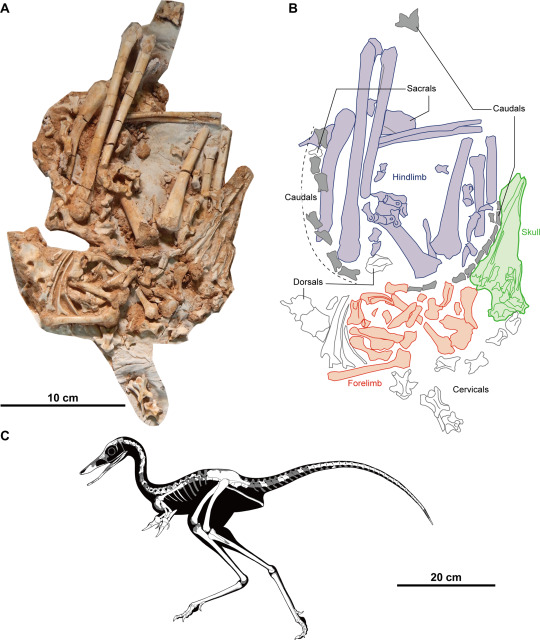
(Type specimen and schematic skeletal of Jaculinykus yaruui, with preserved bones in white on the skeletal, from Kubo et al., 2023)
Meaning of name: Jaculinykus = jaculus [small dragon in Greek mythology] claw [in Greek]; yaruui = speedy [in Mongolian]
Age: Late Cretaceous (Campanian–Maastrichtian?)
Where found: Barun Goyot Formation, Ömnögovi, Mongolia
How much is known: Nearly complete skeleton of one individual.
Notes: Jaculinykus was an alvarezsaurid, a group of unusual small theropods with short but powerful forelimbs, each tipped with an enlarged thumb claw. Their other fingers were highly reduced, and in at least one case (Linhenykus), probably lost entirely. Jaculinykus appears to exhibit an intermediate stage in finger loss, having lost one of the smaller fingers on each hand. This makes it the first known example of an alvarezsaurid with two-fingered hands.
Jaculinykus is also one of the most completely known alvarezsaurids. Most of the bones in the type specimen have probably remained close to the original positions that they were held in when the dinosaur died, and they suggest that Jaculinykus slept in a very bird-like posture with the head turned back and tucked close to the body. A similar sleeping pose had previously been found in the troodontid theropods Sinornithoides and Mei, but Jaculinykus provides the first strong evidence that alvarezsaurids (which were more distant relatives of modern birds than troodontids) adopted the same behavior.
Reference: Kubo, K., Y. Kobayashi, T. Chinzorig, and K. Tsogtbaatar. 2023. A new alvarezsaurid dinosaur (Theropoda, Alvarezsauria) from the Upper Cretaceous Baruungoyot Formation of Mongolia provides insights for bird-like sleeping behavior in non-avian dinosaurs. PLoS ONE 18: e0293801. doi: 10.1371/journal.pone.0293801
366 notes
·
View notes
Text
Jaculinykus
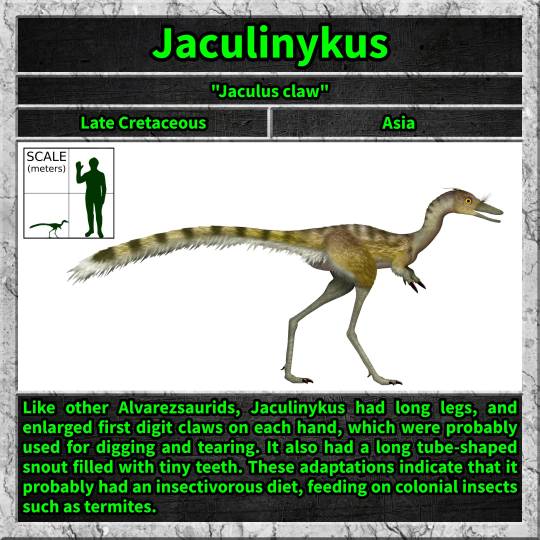
Like other Alvarezsaurids, Jaculinykus had long legs, and enlarged first digit claws on each hand, which were probably used for digging and tearing. It also had a long tube-shaped snout filled with tiny teeth. These adaptations indicate that it probably had an insectivorous diet, feeding on colonial insects such as termites.
79 notes
·
View notes
Photo
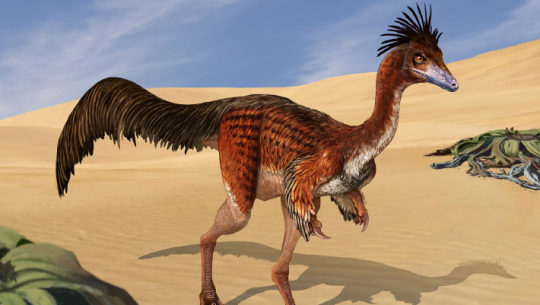
New fossils from Patagonia clarify body plan of Patagonykine dinosaurs
In a new study published in the journal PLoS ONE, paleontologists analyzed the fossilized remains of the alvarezsaurid dinosaur Bonapartenykus from the Allen Formation of Patagonia.
https://www.sci.news/paleontology/patagonykine-body-plan-13634.html
#eartharchives#paleomedia#paleontology#fossil#fossils#evolution#evolutionarybiology#naturalhistory#magazine
13 notes
·
View notes
Text
A wip of some speculative biology dinosaurs will probably post the colored version in the future

2 notes
·
View notes
Text
First evidence of 'hollow bones' found in dinosaurs
#dinosaurs to birds#evolution#biology#evolutionary biology#birds#avian dinosaurs#dinosaurs#did you know#news article#science
9 notes
·
View notes
Text

If he sees this that would make me so happy! Now this was hard to draw. I'm not satisfied with how the eyes turned out and my pencil decided to freak out and leave a smudge on his nose that I couldn't erase, so I had to get rid of it digitally as best I could. All in all I think it's alright.
Darren Naish is a British vertebrate palaeontologist, author, and science communicator. He is well known for his research on dinosaurs and other Mesozoic reptiles, including Eotyrannus, Xenoposeidon, and azhdarchid pterosaurs. Much of his work has focused on fossils from the Wealden Group on the Isle of Wight. Naish founded the vertebrate palaeozoology blog Tetrapod Zoology and has written several popular science books. He frequently appears in media and serves as a scientific consultant for film, television, museums, and exhibitions. Additionally, he has examined cryptozoology and sea monster sightings from a scientific perspective.
Naish earned a geology degree from the University of Southampton and later studied vertebrate palaeontology under David Martill at the University of Portsmouth, where he obtained both an M.Phil. and Ph.D.. His doctoral work focused on the basal tyrannosauroid theropod Eotyrannus, which he and colleagues named in 2001. He has published research on various theropods, including Thecocoelurus, Calamospondylus, and Aristosuchus. Naish has also contributed to studies on sauropod dinosaurs, pterosaurs, fossil marine reptiles, turtles, and marine mammals. His work includes a reinterpretation of the Romanian fossil Heptasteornis, which he and Gareth Dyke argued was an alvarezsaurid.
Beyond his research, Naish has played a significant role in palaeoart and science communication. He co-authored All Yesterdays, a book that explores speculative reconstructions of dinosaurs and other prehistoric animals. The book challenges traditional palaeoart by depicting dinosaurs with plausible but unconventional adaptations. Naish also served as the lead consultant for the Apple TV+ documentary series Prehistoric Planet, which aimed to depict prehistoric life with scientific accuracy. His contributions have helped shape modern interpretations of dinosaurs and their behavior.
#art#drawing#illustration#sketch#artwork#artist#portrait#portrait drawing#portrait art#man#face#darren naish#paleontologist
2 notes
·
View notes
Text

#Archovember Day 25 - Tylocephale gilmorei
The pachycephalosaurids are famous for their thick, armoured heads, but one dome rose above the rest. Living in Late Cretaceous Mongolia, Tylocephale gilmorei, while a medium-sized pachycephalosaur, had the tallest known dome head comparable to body size. This dome could sustain higher forces of impact than other pachycephalosaurids. Like other pachycephalosaurs it likely ate plants and insects, though it had serrations on its teeth that may have allowed it to eat tougher materials like seeds and nuts.
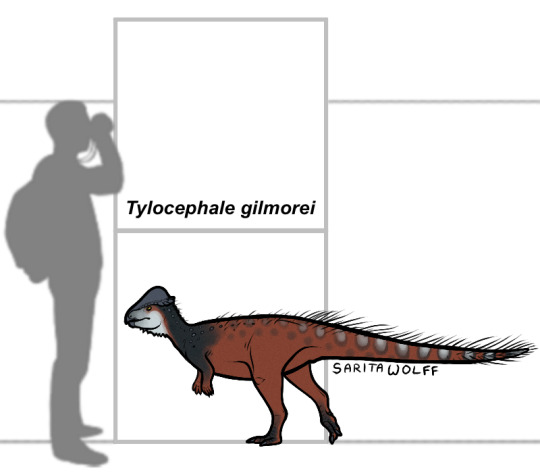
Tylocephale lived in an arid alluvial plain. It lived alongside a variety of other dinosaurs in the Barun Goyot Formation including ankylosaurs like Saichania, Tarchia, and Zaraapelta, protoceratopsids like Bagaceratops and Breviceratops, the titanosaur Quaesitosaurus, dromaeosaurs like Kuru and Shri, halszkaraptorines like Hulsanpes, oviraptorids like Conchoraptor, Heyuannia, and Nemegtomaia, alvarezsaurids like Khulsanurus and Parvicursor, and birds like Gobipipus, Gobipteryx, and Hollanda.
#my art#SaritaDrawsPalaeo#Tylocephale gilmorei#Tylocephale#pachycephalosaurs#pachycephalosaurids#ornithischians#dinosaurs#archosaurs#archosauromorphs#Archovember#Archovember2023
25 notes
·
View notes
Text
Argoland's fauna
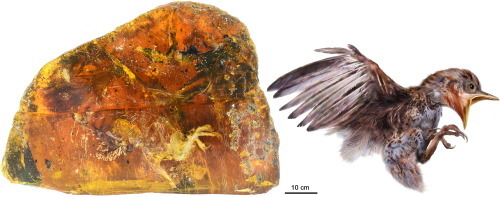
Myanmar amber enantiornithean. Artist uncredited.
Recently a “new” continent was described, Argoland. More accurately described as a series of landmasses that seperated from Gondwanna and attached to Asia in the mid-Cretaceous, such a landmass probably warrants some unique biota.
Well, we do know a significant amount of the microbiota. Most of this is represented in the infamous Myanmar amber, which includes various species of arthropods, an ammonite, various enantiornitheans (of which Fortipesavis and Elektorornis are the only one named), the basal lizard Oculudentavis and the allocaudate Yaksha. The fauna is appropriately recognised as primarily Gondwannan aside from Yaksha, fitting for Argoland’s nature.
Argoland more broadly can presumably answer some Cretaceous oddities, like the presence of both megaraptorans and alvarezsaurids in China and Gondwanna as well as the presence of derived eutherians like zhelestids in the Late Cretaceous of Madagascar and India. The presence of mekosuchines in Australia could also be explained by this landmass, though crocodilian cladistics are constantly shifting.
Overall, this landmasses is could also explain the presence of other gondwannan animals in Eurasia perhaps prior to India like caecilians, though for now more studies are required.
4 notes
·
View notes
